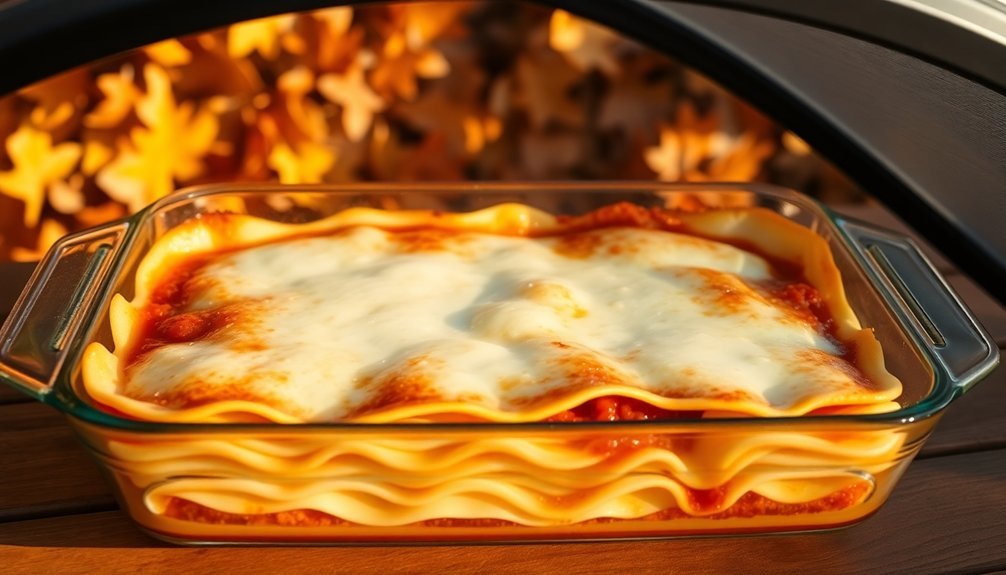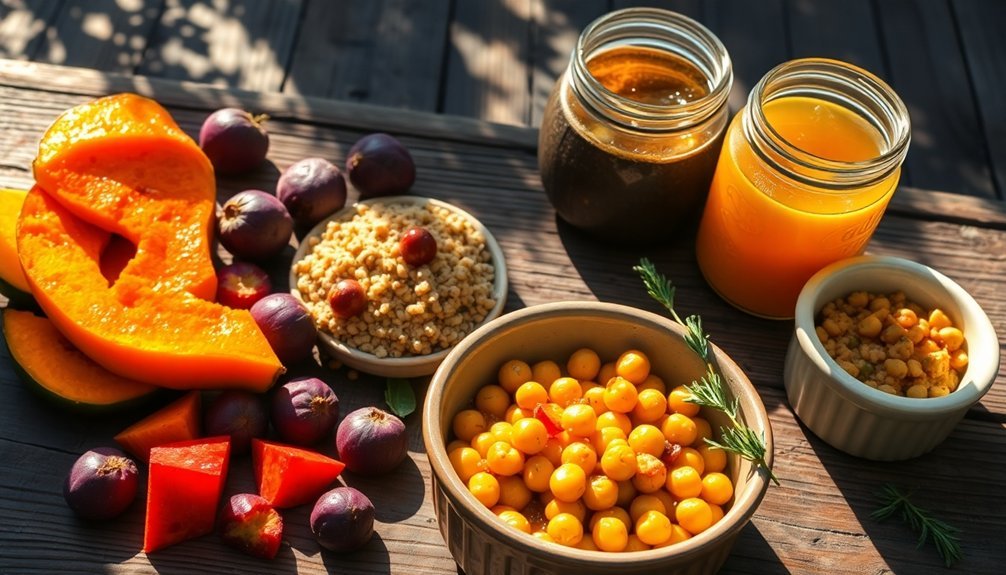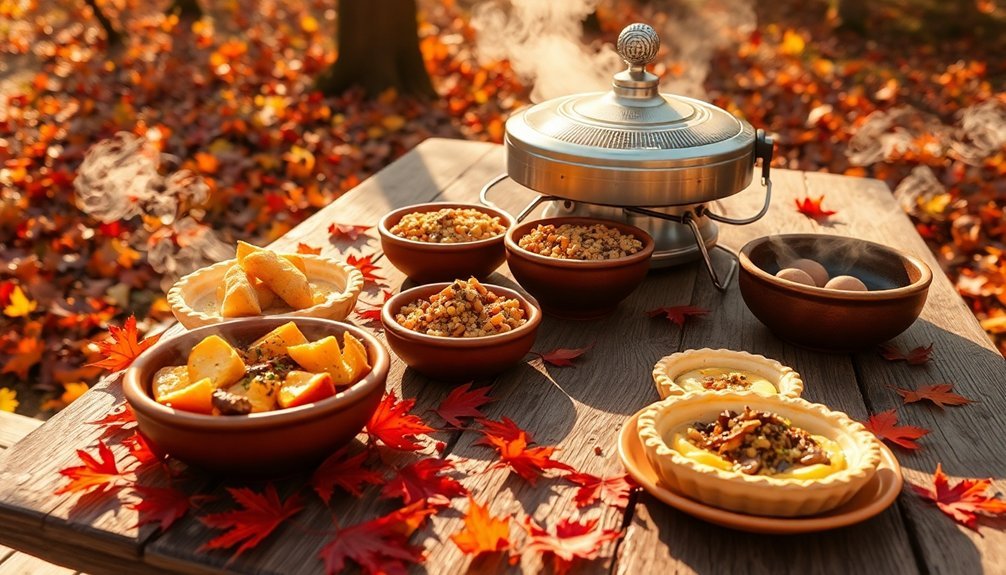Fall's bounty pairs perfectly with solar cooking, offering you five delicious recipes to harness the sun's energy. You'll love starting your day with a warming butternut squash frittata, followed by creamy pumpkin risotto for lunch. For dinner, try the hearty solar lasagne that feeds nine, layered with seasonal ingredients and rich sauce. Don't forget dessert – golden pumpkin scones make a perfect afternoon treat. You'll need to adjust cooking times for solar temperatures between 200°F and 300°F, but the results are worth the wait. These autumn-inspired dishes will transform how you think about eco-friendly cooking.
Warming Fall Breakfast Frittata

Four seasonal vegetables and smoky bacon come together in this cozy fall breakfast frittata that's perfect for chilly mornings.
Start by roasting butternut squash, mushrooms, apples, and onions on a parchment-lined sheet until they're tender and caramelized. You'll want to sauté these gems in a cast-iron skillet before adding your whisked egg mixture. This recipe is incredibly versatile for meals, making it suitable for both breakfast and dinner.
For the silkiest texture, combine your eggs with full-fat dairy and whisk just until blended.
Pour this mixture over your vegetables, sprinkle with feta and parmesan, then bake at 350°F for a creamy interior or 400°F for golden edges.
After 15-20 minutes, you'll have a perfectly set frittata. Let it rest for 10 minutes, then garnish with fresh herbs and serve with avocado slices or peppery arugula.
Seasonal Pumpkin Risotto
Speaking of cozy fall dishes, let's explore another autumn favorite that'll warm you from the inside out.
This creamy pumpkin risotto combines tender Arborio rice with fresh pumpkin, creating a luxurious comfort dish perfect for chilly evenings. The dish's versatile nature makes it an excellent option as either a main course or side dish for your fall dining plans.
You'll start by sautéing garlic and onions in butter, then add cubed pumpkin and rice. Gradually stir in warm broth, allowing each ladleful to absorb before adding more.
The key is patience – this process takes about 25-30 minutes for the rice to reach that ideal al dente texture.
Finish your risotto with freshly grated Parmesan cheese and seasonings. For an elevated touch, top with crispy sage leaves, toasted hazelnuts, or crumbled bacon. You can even add a splash of white wine for extra depth.
Hearty Solar Lasagne

While traditional lasagne requires a conventional oven, this solar-powered version brings an eco-friendly twist to the classic Italian dish.
You'll start by browning your choice of ground meat with onions and garlic, then combining it with a rich tomato sauce. For a seasonal variation, try using roasted butternut squash sauce instead. The recipe makes nine generous servings, perfect for family gatherings.
Layer your ingredients in a solar-safe dish, starting with sauce, followed by lasagna noodles and a creamy mixture of ricotta cheese, eggs, and herbs. Continue layering until you've used all ingredients, finishing with a generous sprinkle of Parmesan on top.
Place your covered dish in a preheated solar oven at around 300°F and let it cook for about 1.5 hours. You'll know it's ready when the cheese is golden and bubbly.
Fresh Pumpkin Scones
As autumn leaves begin to fall, these tender pumpkin scones capture the season's warmest flavors.
You'll combine flour, sugar, baking powder, and aromatic spices like cinnamon, ginger, nutmeg, and cloves in a large bowl. Work cold butter into the mixture until it's crumbly, then blend in your wet ingredients including pumpkin purée and eggs until the dough comes together.
Shape your dough into two circles, cut each into six wedges, and freeze them for 30 minutes to guarantee the best texture.
Bake at 425°F for 22-25 minutes until they're golden brown. You can sprinkle the tops with sparkling sugar before baking or finish them with a spiced pumpkin glaze.
For smaller portions, try using a mini scone pan, reducing the bake time to 18-22 minutes.
Planning Your Solar Menu

Once you've decided to explore solar cooking, planning your fall menu requires careful consideration of both recipes and equipment. You'll want to select dishes that work well at lower temperatures between 200°F and 300°F, focusing on seasonal ingredients like squash, sweet potatoes, and apples.
| Cooker Type | Best Uses | Cooking Tips |
|---|---|---|
| Parabolic | Grilling, frying | Position for direct sun |
| Panel | Rice, vegetables | Best 11am-3pm |
| Box/Oven | Baking, stews | Double cooking time |
| CooKit | Multiple methods | Adjust reflectors |
Remember that solar cooking times typically take twice as long as conventional methods. You'll need to position your cooker in a sunny spot and monitor temperatures with a cooking thermometer. For the best results, choose recipes that don't require rapid cooking, such as stews, casseroles, and roasted fall vegetables.
Frequently Asked Questions
Can Solar Cookers Work Effectively on Cloudy Fall Days?
You'll find solar cookers work less effectively on cloudy fall days. While they'll still function, you'll experience longer cooking times and lower temperatures. It's best to have a backup cooking method available.
What Temperature Range Do Solar Cookers Typically Reach During Autumn Months?
During autumn, you'll typically find your solar cooker reaching temperatures between 140°F to 300°F (60°C to 149°C). However, you might experience lower peaks around 160°F (71°C) depending on sunlight intensity and cooker design.
How Do You Prevent Moisture Buildup in Solar Cookers During Fall?
You'll prevent moisture buildup by quickly venting the lid every few minutes, using absorbent tea towels over your pot, reducing liquid in recipes, and creating small gaps for steam to escape while cooking.
Which Solar Cooker Materials Work Best for Fall Temperature Fluctuations?
You'll want double-glazed glass covers, rigid foam insulation, and PCMs like stearic acid to handle fall's temperature changes. Add reflective aluminum surfaces to maximize sunlight capture during shorter autumn days.
Should Cooking Times Be Adjusted for Lower Fall Sun Angles?
Yes, you'll need to extend your cooking times during fall due to lower sun angles. Plan for 25-50% longer cooking periods and monitor temperatures closely. Keep adjusting your cooker's position throughout preparation.
In Summary
Make the most of autumn's shorter daylight hours by planning your solar cooking schedule strategically. You'll find these five recipes fit perfectly into fall's sunny windows, letting you create warming comfort foods even as temperatures drop. Whether you're baking scones for breakfast or slow-cooking lasagne for dinner, you're harnessing clean solar energy while celebrating the season's hearty flavors and abundant harvest.





Leave a Reply